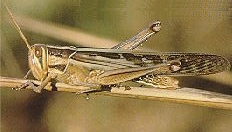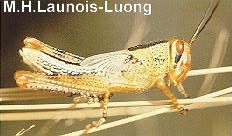Pest locusts
Nomadacris septemfasciata (Serville, 1838)
Family : Acrididae
Sub-family : Cyrtacanthacridinae
Common name : the Red locust
 Nomadacris septemfasciata is a large locust found south of the Sahara in southern parts of Africa. Outbreak centres have been identified in Zambia, Tanzania, Malawi and also Madagascar and Reunion. In the Sahel, the species is observed on a more incidental basis in Cape Verde, the central Niger River delta in Mali and around Lake Chad. Nomadacris septemfasciata is a large locust found south of the Sahara in southern parts of Africa. Outbreak centres have been identified in Zambia, Tanzania, Malawi and also Madagascar and Reunion. In the Sahel, the species is observed on a more incidental basis in Cape Verde, the central Niger River delta in Mali and around Lake Chad.
This acridian is sometimes called "Criquet nomade" in French, due to its nomadic dry season movements. English name Red locust was given in reference to the colour of its hindwings.
Nomadacris septemfasciata belongs to the Cyrtacanthacridinae family like other pests locust, e.g. Schistocerca gregaria (Forskål, 1775), Anacridium melanorhodon melanorhodon (Walker, 1870) and Ornithacris cavroisi (Finot, 1907) for which it is often mistaken.
Moisture is a crucial factor for the Red locust. It actively seeks moist environments in seasonal flood plains with large grassy lowlands and some tree cover of Acacia farnesiana or Mangifera indica to satisfy their semi-arboreal behaviour. It is generally graminivorous. Its biotopes are mixed herbaceous formations with Hyparrhenia, Echinochloa and Cyperus in the upper stratum and Cynodon in the lower stratum. In farming zones, it often colonizes mesohygrotrophic grain crops, especially when the fields are hedged in with bush and when waste and fallow lands are interlaced between the fields. The Red locust becomes sedentary when shelter, perches and food are available.
Nomadacris septemfasciata produces one generation a year, with an imaginal diapause period triggered by reduced daylength in the dry season. Sexual maturity and egg laying are achieved over quite a long period at the beginning of the rainy season, resulting in staggered hatching. Eggs incubate for about one month and hoppers need two months to complete their moulting. There are 6 to 8 instars depending on the sex and phasal state of the individual.
Emerging imagos remain immature until the following rainy season.
Gregarious capabilities are less pronounced in Red locust than in Desert locust and Migratory locust. Outbreak areas are reactivated during dry years in response to the reduced colonizable surface area available to this hygromesophilic acridian, thus increasing population densities to above the critical phase transformation threshold. In invasion years, swarms can be distributed over a few hectares and up to hundreds of square km. Red locusts fly quite slowly with the wind during daylight hours when air temperatures are above 26°C. They never move more than 20-30 km per day. Mature swarms then break up before egg laying, which often occurs at night with eggs being laid in moist sandy-clayey soil. Females congregate in limited areas and lay 70 to 90 eggs/pod. Hatched bands of young hoppers are then capable of travelling hundreds of metres daily in open areas. The imagos remain grouped thus binding the swarms.
Compared to solitarious forms, gregarious Red locusts do not live as long, they develop through 6 instars rather than 7 and sexual maturation takes a longer time. Gregarious females lay fewer eggs and less frequently but emerging hoppers are larger and heavier. Gregarious Red locusts have more markings than the solitarious forms.
Almost all of southern Africa was invaded during the last great widespread plague (1930-1944). Mesohygrotrophic crops cultivated in breeding biotopes were often attacked : corn, rice, sugarcane, fruit, wild herbaceous species and trees such as acacias, eucalyptus and pines. Ecological control was attempted in central Africa, involving environmental modification of outbreak centres but the project was unsuccessful. Chemical control is currently being used. Research should now be directed towards improving spraying techniques and selecting better acridicides.
The Red locust can be easily identified by its typical body colour. The overall colour is a mixture of light beige and brown. It is never green. There are seven clear transversal brown bands on the elytra (thus explaining its species name septemfasciata and its hindwings are red. There are two typical wide lateral brown bands on the pronotum.
Hoppers can also be recognized by their colouring but there is a broad range of phase-related colour differences. Solitary hoppers can be green or brown and gregarious hoppers are bright yellow with black markings.
General morphology
 |
Size : males are 60-70 mm long, females are 60-85 mm long. |
Overall body colour
This species is easily identified by its overall colour which is a mixture of light beige and brown. There is no green form. There are 7 clearly distinguishable transversal brown bands on the elytra.
There are 2 characteristic wide lateral brown bands on the pronotum. Gregarious locusts become yellowish as they mature sexually.
Solitary hoppers are an overall green or brown and they are solid brown, yellow or black in the gregarious phase. |
 |
Wing colour
 |
Red. Hindwings are reddish. |
Prosternal tubercle present
|